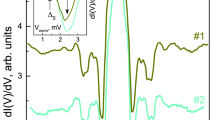Abstract
We have measured the tunneling spectra of some high temperature superconducting crystal break junctions at 4 K. The samples were thin plates of Bi2SrCa2Cu2O8 compound. The tunneling spectra (conductance versus voltage) were not typical of BCS superconductor tunneling electrodes. The spectra of higher-resistance break-junction settings (R > 1 MΩ) show a tunneling gap on top of a linearly increasing conductance background signal. “Harmonic” dip features in the spectra of lower resistance break junction settings (R < 1 MΩ) indicated tunneling between multiple particles in the vicinity of the primary (highest resistance) contact of the junction. The dips occurred at about the same current but shifted in voltage when the resistance of the break junction was continuously adjusted to new settings.
Contribution of the National Institute of Standards and Technology, not subject to copyright.
Access this chapter
Tax calculation will be finalised at checkout
Purchases are for personal use only
Preview
Unable to display preview. Download preview PDF.
Similar content being viewed by others

References
J. Moreland, L. F. Goodrich, J. W. Ekin, T. E. Capobianco, and A. F. Clark, Anomalous behavior of tunneling contacts in superconducting perovskite structures, in: “Advances in Cryogenic Materials, vol. 34,” A. F. Clark and R. P. Reed, eds., Plenum, New York, pp. 625–632 (1988).
K. E. Gray, Tunneling spectroscopy of novel superconductors, in: “Novel Superconductivity,” S. A. Wolf and V. Z. Kresin, eds., Plenum, New York, pp. 611–625 (1988).
M. Lee, D. B Mitzi, A. Kapitulnik, and M. R. Beasley, Electron tunneling and the energy gap in Bi2Sr2CaCu2Ox, Phys. Rev. B. 39:801 (1989).
T. P. Orlando, K. A. Delin, S. Foner, E. L. McNiff Jr., J. M. Tarascon, L. H. Greene, W. R. McKinnon, and G. W. Hull, Upper critical fields of high-Tc superconducting Y2_xBaxCuO2-y, Phys. Rev. B, 35:7249 (1987).
J. Moreland, A. F. Clark, M. A. Damento, and K. A. Gschneidner Jr., Single crystal HoBa2Cu3Ox break junctions, Physica C, 153–155:1383 (1988).
J. Moreland, D. S Ginley, E. L. Venturini, and B. Morosin, Break junction measurement of the tunneling gap of a thallium based high temperature superconductor crystal, submitted to Appl. Phys. Lett. (1989).
J. Moreland and J. W. Ekin, Electron tunneling experiments using Nb-Sn “break” junctions, J. Appl. Phys., 58:3888 (1985).
D. S. Ginley, B. Morosin, R. J. Baughman, E. L. Venturini, J. E. Schriber, and J. F. Kwak, Growth of crystals and effects of oxygen annealing in the Bi-Ca-Sr-Cu-O and Tl-Ca-Ba-Cu-O superconductor systems, J. Crystal Growth, 91:456 (1988).
A. F. Hebard and P. W. Shumate, A new approach to high resolution measurements of structure in superconducting tunneling currents, Rev. Sci. Instrum. 45:529 (1974).
G. Briceno and A. Zettl, Tunneling spectroscopy in Bi2Sr2CaCu2O8: Is the energy gap anisotropic?, Solid State Comm. 70:1055 (1989).
R. Esudero, F. Morales, F. Estrada, and R. Barrio, Tunneling measurements in the B: superconductors, Mod. Phys. Lett. 3:73 (1989).
J. Moreland, L. F. Goodrich, J. W. Ekin, T. E. Capobianco, and A. F. Clark, Electron Tunneling Measurements of High Tc compounds using break junctions, Jap. J. Appl. Phys.. 26–3:999 (1987).
Author information
Authors and Affiliations
Editor information
Editors and Affiliations
Rights and permissions
Copyright information
© 1990 Plenum Press, New York
About this chapter
Cite this chapter
Moreland, J., Chiang, C.K., Swartzendruber, L.J. (1990). Break Junction Tunneling Spectroscopy of Single-Crystal Bismuth-Based High-Temperature Superconductors. In: Reed, R.P., Fickett, F.R. (eds) Advances in Cryogenic Engineering Materials . An International Cryogenic Materials Conference Publication, vol 36. Springer, Boston, MA. https://doi.org/10.1007/978-1-4613-9880-6_80
Download citation
DOI: https://doi.org/10.1007/978-1-4613-9880-6_80
Publisher Name: Springer, Boston, MA
Print ISBN: 978-1-4613-9882-0
Online ISBN: 978-1-4613-9880-6
eBook Packages: Springer Book Archive


